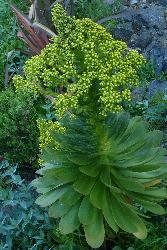- Taxon
- Gallery
Monocarpic or rarely perennial; stem trunk-like, not branched or with few short branches below infl., to c. 1.5 m high and usually 2–3 cm diam., sometimes smaller in exposed positions, with prominent, brown, lozenge-shaped scars. Rosettes terminal, 15–30 cm diam. on main stem, flattened except in summer. Outer rosette lvs to 24 × 6 cm, 2–4 mm thick, spathulate or obovate-spathulate, green, glabrous and ± flat on both surfaces; margins ciliate, ± red or reddish brown especially towards the mucronulate or mucronate apex. Flowering shoots terminal, the plant usually dying after flowering; axis very stout, tall, erect, glabrous or very rarely with minute glandular hairs, with numerous small leafy bracts up to flowering. Infl. a massive, broadly pyramidal panicle, ± acutely pointed at the top, usually 25–40 × 18–25 cm, sometimes smaller in exposed positions; fls ± secund along branches. Calyx lobes 1.2–3 mm long, usually glabrous, very rarely with minute glandular hairs, elliptic-lanceolate to triangular. Petals 8–11–(12), 6.5–10 × 2–3 mm, linear, linear-lanceolate to lanceolate-elliptic or narrowly oblong-elliptic, golden. Stamens yellow, the inner whorl 6–8.5 mm long, the outer whorl almost = inner. Carpels yellow or greenish yellow. Scales 0.4–0.7 mm long, ± square to rectangular-cuneate, sometimes slightly emarginate. Seeds 0.6–0.8 mm long, ± obovoid, minutely longitudinally streaked.
[From: Webb et al. (1988) Flora of New Zealand. Volume 4.]
Flowering: Oct.–Nov.–(Dec.)




